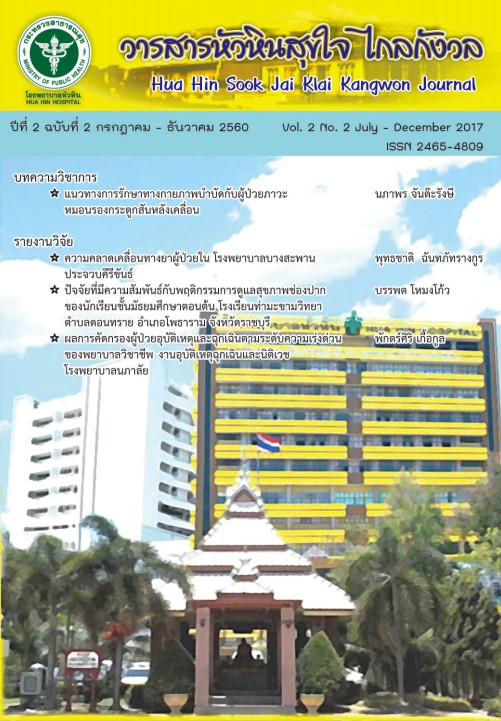Results of the Patient Screening According to Emergency Severity Index of Nurses accident and emergency unit at Naphalai Hospital
Keywords:
3 level severity screening, emergency severity index (ESI) screening, ccident and emergency unitAbstract
The objective of this cross-sectional research was to study the screening results of accident and emergency patients according to 3 level of severity and emergency severity index (ESI), duration of service receiving at accident and emergency unit, compare with waiting period for medical examination by physician according to ESI criteria, satisfaction of service receivers, and problems of applying patients screening according to ESI by accident and emergency nurses at Naphalai Hospital. The samples consisted of 13 accident and emergency nurses and 400 patients who got medical care at accident and emergency room. Data was collected by questionnaire and screening record form during May to September 2017, and analyzed by descriptive statistics and analysis statistics such as Paired t-test and One sample t-test. The study found the followings: 3 level of severity screening had a good effect at 15.4%, for ESI had a good effect at 84.6%. When comparing the applied results between 3 level severity screening with ESI, found that the applying result of the ESI screening was better than the 3 level of severity screening by statistical significance (P-value <0.001). According to ESI; nurses performed patients illness screening as followings, resuscitation patients were conducted screening immediately, followed by patients with emergency, urgency, semi-urgency and non-urgency were conducted screening averagely at 1 minute, 3 minutes, 3 minutes and 10 minutes respectively. When were refer patients to doctors after screening, resuscitation patients took an average of 1 minute waiting for doctor, followed by patients with emergency, urgency, semi-urgency and non-urgency took an average of 2 minutes, 7 minutes, 6 minutes and 6 minutes waiting for doctor, respectively. When comparing waiting time for medical examination with patient screening criteria based on ESI of patients in each category, showed that each category of patients spent waiting time for medical examination less than screening criteria, especially, emergency, urgency and semi-urgency patients less than screening criteria by statistical significance (P-value <0.001). Satisfaction for whole services at accident and emergency unit; there were 94.8% at high level. Problems of screening patients based on the ESI, found that lack of knowledge about the screening of patients according to ESI at 15.4%. Thus, there should be use ESI and develop the screening methods to identify patients with fewer errors, as well as, make the patients see the doctor faster.
References
ศศิวิมล พงษ์นิลละอาภรณ์. การพัฒนาและการใช้แนวปฏิบัติทางคลินิกสำหรับการจำแนกผู้ป่วยที่ห้องฉุกเฉิน โรงพยาบาลพะเยา.วิทยานิพนธ์
พยาบาลศาสตรมหาบัณฑิต (สาขาวิชาการพยาบาลผู้ใหญ่) มหาวิทยาลัย เชียงใหม่. 2552.
อัมภา ศรารัชต์, จินนะรัตน์ ศรีภัทรภิญโญ, และอมรรัตน์ อนุวัฒน์นนทเขตต์. การจำแนกประเภทผู้ป่วยงานบริการพยาบาลผู้ป่วยใน. สำนักการพยาบาล กรมสำนักงานปลัดกระทรวงสาธารณสุขกระทรวงสาธารณสุข กรุงเทพฯ องค์การรับส่งสินค้าและพัสดุภัณฑ์. 2557.
Wuerz, R., & Fernandes, C.M.B. Inconsistency of Emergency Department Triage. Annals of Emergency Medicine, 32, 431 – 435. 1998.
Anderson, A.K., Omberg, M., & Svedlund, M. Triage in the Emergency Department : A Qualitative Study of the Factors which
Nurses Consider when Marking Decisions. Nursing in Clinical Care. 11, 136-145, 2006.
Gerdtz M.F., & Bucknall, T.K. Triage Nurses’ Clinical Decision Making: An Observational Study of Urgency Assessment. Journal of
Advanced Nursing, 35, 550-561. 2001.
Travers,D.A., Waller,A.E., Bowling,J.M.,& Tintinalli,J. Five-level Triage System more Effective than Three-level in Tertiary
Emergency Department. Journal of Emergency Nursing, 28, 395-400. 2002.
โรงพยาบาลนภาลัย. ปัญหาการคัดกรองผู้ป่วยอุบัติเหตุและฉุกเฉิน. สมุทรสงคราม : โรงพยาบาลนภาลัย, 2559.
Australasian College for Emergency Medicine. The Australasian Triage Scale (ATS). (online) Available URL :
http://www.acem.org.aulopen/documents/triage.htm. (Retrieved : October 10, 2017) 2002.
รังสฤษฎ์ รังสรรค์. การคัดกรองผู้ป่วยด้วยระบบ Emergency Severity Index (ESI). (online) Available URL : http://
ergoldbook.blogspot.com/2012/10/emergency-severity-index-esi.html (Retrieved : October 10, 2017) 2555.
ภาสินี คงเพ็ชร์. ผลการใช้รูปแบบการคัดกรองผู้ป่วยตามระดับความเร่งด่วน ของพยาบาลวิชาชีพ งานอุบัติเหตุและฉุกเฉิน โรงพยาบาลเกาะสมุย. สุราษฎร์ธานี : รายงานวิจัย. 2557.
สุมาลี จักรไพศาล, ชฎาภรณ์ เปรมปรามอมรและณัฐนันท์ มาลา. ผลการคัดกรองผู้ป่วยโดยใช้ดัชนีความรุนแรงฉุกเฉินสระบุรี ต่อความสอดคล้อง
ของการจาแนกระดับความรุนแรงของผู้ป่วยระยะเวลารอคอยแพทย์ตรวจ ความพึงพอใจของผู้ใช้บริการ และความพึงพอใจในงานของพยาบาล
หน่วยงานอุบัติเหตุและฉุกเฉิน โรงพยาบาลสระบุรี. สระบุรี: รายงานวิจัย. 2553.
Hostutler, J.J, Taft, S.H., & Synder,C. Patient needs i the Emergency Department Nurses and Patients Perceptions. Journal of
Nursing Administration, 29(1), 43-50. 1999.
Downloads
Published
How to Cite
Issue
Section
License
บทความที่ได้รับการตีพิมพ์ในวารสารหัวหินเวชสาร เป็นลิขสิทธิ์ของโรงพยาบาลหัวหิน
บทความที่ลงพิมพ์ใน วารสารหัวหินเวชสาร ถือว่าเป็นความเห็นส่วนตัวของผู้เขียนคณะบรรณาธิการไม่จำเป็นต้องเห็นด้วย ผู้เขียนต้องรับผิดชอบต่อบทความของตนเอง







